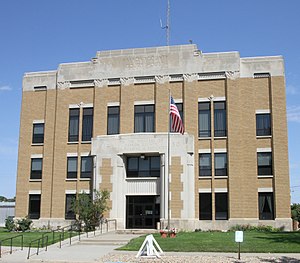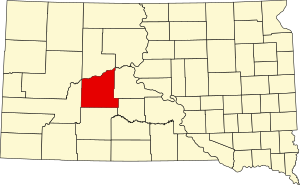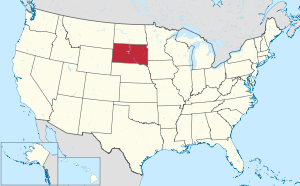County in South Dakota
| Haakon County | |
|---|---|
| County | |
 Haakon County Courthouse in Philip Haakon County Courthouse in Philip | |
 Location within the U.S. state of South Dakota Location within the U.S. state of South Dakota | |
 South Dakota's location within the U.S. South Dakota's location within the U.S. | |
| Coordinates: 44°18′N 101°32′W / 44.3°N 101.53°W / 44.3; -101.53 | |
| Country | |
| State | |
| Founded | 1914 (created) 1915 (organized) |
| Named for | Haakon VII of Norway |
| Seat | Philip |
| Largest city | Philip |
| Area | |
| • Total | 1,827 sq mi (4,730 km) |
| • Land | 1,811 sq mi (4,690 km) |
| • Water | 16 sq mi (40 km) 0.9% |
| Population | |
| • Total | 1,872 |
| • Estimate | 1,851 |
| • Density | 1.0/sq mi (0.40/km) |
| Time zone | UTC−7 (Mountain) |
| • Summer (DST) | UTC−6 (MDT) |
| Congressional district | At-large |
| Website | haakon |
Haakon County is a county in the U.S. state of South Dakota. As of the 2020 census, the population was 1,872. Its county seat is Philip.
History
The county was created in 1914 and organized in 1915, and was formed from the original counties of Nowlin and most of Sterling, which had previously been absorbed by Stanley County. It is named for Haakon VII, who became king of Norway in 1905, in order to attract Norwegian settlers to the county. It is the only county in South Dakota named for a non-American person and is one of only nine counties in South Dakota named for persons who did not live in South Dakota. Most of South Dakota's counties are named for early South Dakota officials or legislators, or for physical features (Fall River and Lake), or are derived from Native American words (Minnehaha and Yankton), or from counties in other states (Jones and Walworth), with one (Aurora) named for a Roman goddess, one for an animal (Buffalo), and one (Union) for a concept.
Geography
The terrain of Haakon County consists of semi-arid rolling hills, carved with gullies and drainages, partially devoted to agriculture. The Cheyenne River, a tributary of the Missouri River, flows northeastward along the county's north boundary line, and the Bad River flows east-northeastward through the lower part of the county, both heading for their discharge points into the Missouri. The terrain slopes to the northeast, and its highest point is near the midpoint of its western boundary line, at 2,802 ft (854 m) ASL.
Haakon County has a total area of 1,827 square miles (4,730 km), of which 1,811 square miles (4,690 km) is land and 16 square miles (41 km) (0.9%) is water.
The eastern portion of South Dakota's counties (48 of 66) observe Central Time; the western counties (18 of 66) observe Mountain Time. Haakon County is the easternmost of the SD counties to observe Mountain Time.
Major highways
Adjacent counties
- Ziebach County - north
- Stanley County - east
- Jones County - southeast (observes Central Time)
- Jackson County - south
- Pennington County - west
Protected areas
- Billsburg State Game Production Area
- Cheyenne State Game Production Area (part)
Lakes
Source:
- Waggoner Lake
Demographics
| Census | Pop. | Note | %± |
|---|---|---|---|
| 1920 | 4,596 | — | |
| 1930 | 4,679 | 1.8% | |
| 1940 | 3,515 | −24.9% | |
| 1950 | 3,167 | −9.9% | |
| 1960 | 3,303 | 4.3% | |
| 1970 | 2,802 | −15.2% | |
| 1980 | 2,794 | −0.3% | |
| 1990 | 2,624 | −6.1% | |
| 2000 | 2,196 | −16.3% | |
| 2010 | 1,937 | −11.8% | |
| 2020 | 1,872 | −3.4% | |
| 2023 (est.) | 1,851 | −1.1% | |
| U.S. Decennial Census 1790-1960 1900-1990 1990-2000 2010-2020 | |||
2020 census
As of the 2020 census, there were 1,872 people, 773 households, and 510 families residing in the county. The population density was 1.0 inhabitant per square mile (0.39/km). There were 931 housing units.
2010 census
As of the 2010 census, there were 1,937 people, 850 households, and 540 families in the county. The population density was 1.1 inhabitants per square mile (0.42/km). There were 1,013 housing units at an average density of 0.6 per square mile (0.23/km). The racial makeup of the county was 94.7% white, 1.9% American Indian, 0.4% Asian, 0.2% black or African American, 0.1% Pacific islander, 0.2% from other races, and 2.6% from two or more races. Those of Hispanic or Latino origin made up 0.9% of the population. In terms of ancestry, 45.4% were German, 19.4% were Irish, 17.6% were Norwegian, 8.6% were English, 6.2% were Czech, 5.1% were Dutch, and 1.2% were American.
Of the 850 households, 23.8% had children under the age of 18 living with them, 56.6% were married couples living together, 4.2% had a female householder with no husband present, 36.5% were non-families, and 33.2% of all households were made up of individuals. The average household size was 2.24 and the average family size was 2.86. The median age was 48.8 years.
The median income for a household in the county was $46,281 and the median income for a family was $60,000. Males had a median income of $37,679 versus $22,277 for females. The per capita income for the county was $25,877. About 13.2% of families and 12.5% of the population were below the poverty line, including 14.9% of those under age 18 and 13.7% of those age 65 or over.
Housing cost
In 2007, the average price (in US dollars) for housing was:
- Single family home: $143,052
- Town homes and other attached homes: $116,019
- Twin homes: $176,744
- Mobile homes: $51,477
Communities
Towns
Unincorporated communities
Source:
- Billsburg
- Kirley
- Milesville
- Nowlin
- Ottumwa
- West Fork
Unorganized territories
- East Haakon
- West Haakon
Politics
The Haakon County voters are reliably Republican. In no national election since 1936 has the county selected the Democratic Party candidate.
| Year | Republican | Democratic | Third party(ies) | |||
|---|---|---|---|---|---|---|
| No. | % | No. | % | No. | % | |
| 2024 | 1,004 | 89.24% | 105 | 9.33% | 16 | 1.42% |
| 2020 | 1,026 | 90.24% | 105 | 9.23% | 6 | 0.53% |
| 2016 | 936 | 89.66% | 77 | 7.38% | 31 | 2.97% |
| 2012 | 940 | 86.08% | 138 | 12.64% | 14 | 1.28% |
| 2008 | 939 | 81.44% | 187 | 16.22% | 27 | 2.34% |
| 2004 | 1,007 | 81.21% | 219 | 17.66% | 14 | 1.13% |
| 2000 | 938 | 83.08% | 164 | 14.53% | 27 | 2.39% |
| 1996 | 887 | 68.81% | 284 | 22.03% | 118 | 9.15% |
| 1992 | 860 | 65.25% | 209 | 15.86% | 249 | 18.89% |
| 1988 | 958 | 70.91% | 379 | 28.05% | 14 | 1.04% |
| 1984 | 1,168 | 82.84% | 237 | 16.81% | 5 | 0.35% |
| 1980 | 1,162 | 79.32% | 255 | 17.41% | 48 | 3.28% |
| 1976 | 812 | 61.89% | 477 | 36.36% | 23 | 1.75% |
| 1972 | 1,021 | 73.14% | 366 | 26.22% | 9 | 0.64% |
| 1968 | 759 | 60.96% | 377 | 30.28% | 109 | 8.76% |
| 1964 | 795 | 54.56% | 662 | 45.44% | 0 | 0.00% |
| 1960 | 980 | 62.22% | 595 | 37.78% | 0 | 0.00% |
| 1956 | 936 | 61.18% | 594 | 38.82% | 0 | 0.00% |
| 1952 | 1,176 | 74.81% | 396 | 25.19% | 0 | 0.00% |
| 1948 | 753 | 57.92% | 519 | 39.92% | 28 | 2.15% |
| 1944 | 638 | 62.61% | 381 | 37.39% | 0 | 0.00% |
| 1940 | 1,129 | 61.49% | 707 | 38.51% | 0 | 0.00% |
| 1936 | 933 | 47.70% | 948 | 48.47% | 75 | 3.83% |
| 1932 | 797 | 35.68% | 1,245 | 55.73% | 192 | 8.59% |
| 1928 | 1,255 | 64.33% | 663 | 33.98% | 33 | 1.69% |
| 1924 | 797 | 49.87% | 319 | 19.96% | 482 | 30.16% |
| 1920 | 713 | 49.65% | 393 | 27.37% | 330 | 22.98% |
| 1916 | 399 | 41.05% | 475 | 48.87% | 98 | 10.08% |
See also
References
- ^ "State & County QuickFacts". United States Census Bureau. Retrieved March 21, 2024.
- "Find a County". National Association of Counties. Retrieved June 7, 2011.
- "Dakota Territory, South Dakota, and North Dakota: Individual County Chronologies". Dakota Territory Atlas of Historical County Boundaries. The Newberry Library. 2006. Archived from the original on April 2, 2018. Retrieved March 29, 2015.
- SDPB. "How did Haakon County, South Dakota get its name? Temples of Justice". Youtube. South Dakota Public Broadcasting. Retrieved December 5, 2024.
- Clay, Custer, Douglas, Grant, Hamlin, Lincoln, McPherson, and Meade are the other eight.
- ^ "Haakon County · South Dakota". Google Maps. Retrieved April 27, 2024.
- ""Find an Altitude" Google Maps (accessed February 3, 2019)". Archived from the original on May 21, 2019. Retrieved February 3, 2019.
- "2010 Census Gazetteer Files". United States Census Bureau. August 22, 2012. Retrieved March 26, 2015.
- Map of Time Zone Line through South Dakota (accessed January 30, 2019)
- "County Population Totals and Components of Change: 2020-2023". Retrieved March 17, 2024.
- "U.S. Decennial Census". United States Census Bureau. Retrieved March 26, 2015.
- "Historical Census Browser". University of Virginia Library. Retrieved March 26, 2015.
- Forstall, Richard L., ed. (March 27, 1995). "Population of Counties by Decennial Census: 1900 to 1990". United States Census Bureau. Retrieved March 26, 2015.
- "Census 2000 PHC-T-4. Ranking Tables for Counties: 1990 and 2000" (PDF). United States Census Bureau. April 2, 2001. Archived (PDF) from the original on October 9, 2022. Retrieved March 26, 2015.
- "US Census Bureau, Table P16: Household Type". United States Census Bureau. Retrieved March 21, 2024.
- "Haakon County, South Dakota detailed profile - houses, real estate, cost of living, wages, work, agriculture, ancestries, and more". www.city-data.com. Retrieved April 15, 2018.
- Leip, David. "Atlas of US Presidential Elections". uselectionatlas.org. Retrieved April 15, 2018.
| Places adjacent to Haakon County, South Dakota | ||||||||||||||||
|---|---|---|---|---|---|---|---|---|---|---|---|---|---|---|---|---|
| ||||||||||||||||
| Municipalities and communities of Haakon County, South Dakota, United States | ||
|---|---|---|
| County seat: Philip | ||
| City |  | |
| Town | ||
| Unincorporated communities | ||
| Indian reservation | ||
| Ghost towns | ||
| Footnotes | ‡This populated place also has portions in an adjacent county or counties | |
44°18′N 101°32′W / 44.30°N 101.53°W / 44.30; -101.53
Categories: